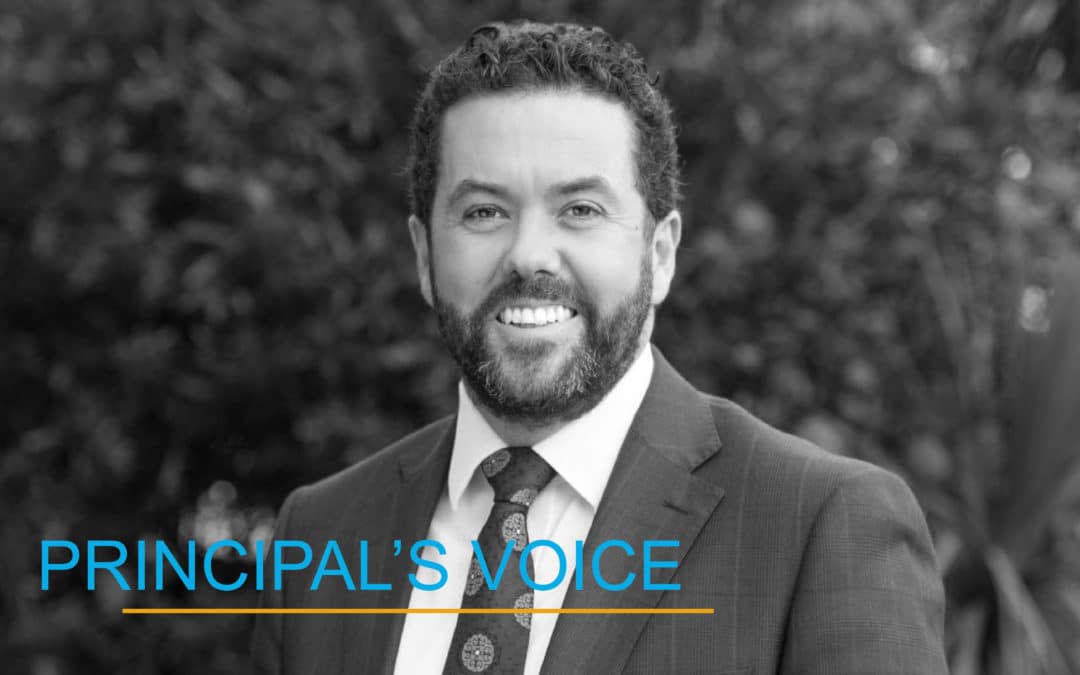The purposes of a person’s heart are deep waters, but one who has insight draws them out. – Proverbs 20:5
At the start of 2020 we enjoyed seeing a campus full of students. All of the work preparing programs, scope and sequence documents, lessons, completing professional development including Child Protection training, adding detail to our strategic plan, examining survey feedback, working on the physical facilities, all of it pales in comparison to seeing students back, relating and learning. We work with families to help our students love learning, build capacity and character, and grow into fine young men and women. This is a long journey, one that can sometimes seem endless. However, it is invariably worth it. I trust that holidays were a time of refreshment for families and students alike. I acknowledge that it was not the case for all. As we enter a new year of learning, I am keen to share some principles from the Australian Psychological Society that help navigate natural disasters including bushfires. I trust that this may be of assistance for all of us as we prepare our students to face an uncertain world in a healthy manner and help them to know and manage themselves in it. The following is drawn from material that can be accessed in full at https://www.psychology.org.au/for-the-public/Psychology-topics/Disasters/Bushfires
Psychological Preparedness for Disasters
Anticipate that the situation will be stressful, identify how we and our children have typical physical and emotional responses to stress, and whether there are any thoughts that are adding to our fear. Once we have anticipated and identified our responses, we can then manage how we feel and think, through things like breathing exercises and self-talk (replacing unhelpful thoughts with helpful ones).
Preparing Children for, and helping them after, Bushfires and other Disasters
Children are sometimes unable to express how they feel, and therefore signs of distress and or feelings can be seen in changes to their behaviour – these might include trouble sleeping, irritability, a change in eating patterns, withdrawal, or becoming clingy, feelings of anxiety, aggression or outbursts, questions about death or dying, or complaints about tummy pains or headaches. (These symptoms can be indicative of all sorts of anxiety, including about returning to school for some). It is helpful for us to monitor media exposure, not everything is helpful for them to see, therefore we need to limit exposure as needed, and discuss difficult material in a caring and reassuring way. It is important to listen to children to understand how they are feeling and how they are thinking. This will help us to identify any misconceptions and help them process what they are hearing, seeing or experiencing. Giving children an opportunity to express feelings, whether through play or words is valuable. Reassuring children provides them with the comfort and support that they seek. This helps them to feel safe and cared for. Let them know about those working for their safety and try, where possible, to keep routines predictable. As adults, we need to take care about how we speak in front of children, considering their age and stage. We also need to pay attention to our reactions as our children, for good or ill, take their cues from us. As adults, we also need to look after ourselves to be better equipped to look after others.
Useful Tips for Disaster Recovery
While none of these tips is particularly new or ground-breaking, together they can help sharpen our focus and remind us of the things that are important. We know the importance of not letting social connections slip, we know that it is important to get back to doing the things we enjoy, we know that we need to solve problems, but sometimes we don’t have the wherewithal to do so. Of all the tips for disaster recovery, managing emotional distress and practising helpful thinking are perhaps the most powerful. Managing emotional distress is about identifying it, often as a physical symptom, realising what it is, for example, my headache isn’t simply a headache, but a bodily reaction to anxiety. Once we know this, the next steps include anticipating triggers for distress and then managing that distress through relaxation or conversation or by minimising our exposure to triggers. A key element of helpful thinking is to catch unhelpful thoughts and to reframe them. This reframing or self-talk can help us to see the world in ways that enable us to see the world differently. When unhelpful thoughts occur – for instance, “everything is ruined, it will never be right again”, we need to acknowledge how we feel, but try to head in a more helpful direction, for instance “this is hard, but I’ll do what I can, piece by piece” or “I’ve managed so far and discovered strengths I didn’t realise”. My hope is that all the above proves to be unnecessary, but my experience tells me that it’s necessary. My experience tells me that we know it, but it is good to be reminded of it as we need it, for the ordinary disasters that can befall a student’s world, as well as for those on the broadest scale.
Tim Watson Principal





